Room of the Segnatura
The first of the Stanze to be painted, from the end of 1508 until 1511, was that of the Segnatura.
When Raphael began the work had to be the library of Julius II, but just ended was destined to the highest court of the church: the Segnatura Gratiae et Iustitiae.
The composition of the frescoes answers Neoplatonic categories of Truth, Beauty and Goodness, which correspond to the frescoes on the four walls.
| The Dispute of the Sacrament represents the Theological True |
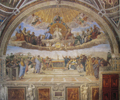 |
The School of Athens represents the Philosophical True |
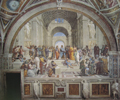 |
| The Parnassus is the Beauty |
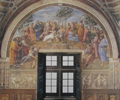 |
The Virtue and Justice represents the Goodness |
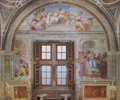 |
In the vault within the tondi, at the relevant wall, are shown:
The Theology over
the Dispute |
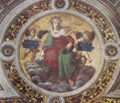 |
The Philosophy over
the School of Athens |
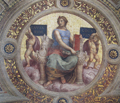 |
The Poetry over
the Parnassus |
 |
The Justice over
the Virtues |
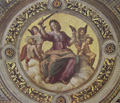 |
The decoration of the Stanza of the Segnatura began with the vault, note that this was the first trial of Raphael's painting frescoes.
Julius II had set to work beyond the young Raphael, the greatest painters of the time: Perugino, Bramantino, Baldassarre Peruzzi, Lorenzo Lotto, Sodoma, but as he saw the tondo, that Raphael had painted in the vault dismissed all others and ordered to destroy the frescoes already painted. But Raphael called Sodoma and saved the frescoes by Perugino.
After the vault Raphael devoted himself to the Dispute of the Sacrament (1509), a term handed down by Vasari who speaks of dispute, that is discussion among theologians.
To attest the commitment of Raphael about the Dispute were found 40 preparatory drawings.
It is natural to ask why Raphael has dedicated to Dispute a study so thorough, the plausible reason is that the representation Raphael is new, in fact the characters are portrayed in full action in a narrative language never experienced before,
| with the intention, happily managed, of overcoming the abstractions of the past, to make vivid and enthralling the representation |
 |
among the various characters: popes, saints, theologians, also appears Dante Alighieri. |
 |
In the School of Athens (1509 - 1510), Raphael further develops the narrative representation, which takes place in a space architecturally defined.
At the center we see Plato, with the face of Leonardo da Vinci, who raises his arm pointing his finger at the sky, while Aristotle (Bastiano da Sangallo), with his arm stretched forward with the hand indicates the earth.
Almost all the characters pictured: Pythagoras, Euclid, Zoroaster, have the faces of artists of the time of Raphael, for example, Euclid has the face of Bramante, Zoroaster that of Baldassarre Castiglione and in the right corner also appear Raphael and Sodoma. An interesting notation is that in 1511, when it was discovered the first part of the vault of the Sistine Chapel, Raphael repainted the School of Athens including Heraclitus with the face of Michelangelo, not only, the same features take back the style of Michelangelo.
For a thorough exploration of the School of Athens, we recommend to use the image navigable below:

The next fresco to be painted was the Parnassus (1510 - 1511), overlooking the courtyard of the Belvedere, where Julius II ordered to carry, saving them, the many statues found in archaeological excavations, including the Apollo Belvedere and the Laocoon,
| not at all Homer’s face is just that of Laocoon |
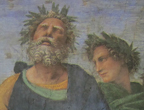 |
and Apollo, left the mountain of the Muses, sits on the Mons Vaticanus, intended as the new Parnassus, surrounded by the faithful Muse in front of the Apollo Belvedere. |
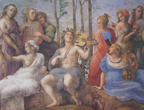 |
Among the 18 poets over Homer we see
| Virgil, Dante |
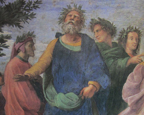 |
and Saffo. |
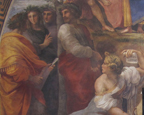 |
The fresco of the Virtues was painted in 1511, the wall due to the irregularity of the eccentric window posed problems, which Raphael resolved by articulating the composition into three parts separated by an illusionistic architecture.
In the lunette are shown on the left the Fortress, recognizable by his helmet, in the center the Prudence and finally, with the reins, the Temperance. Three putti represent the theological virtues: Faith, Hope and Charity. |

The lunette |
On the left of the window you see Teboniano that delivers the Pandects to Justinian, symbolizing the natural land the civil law. The painting was severely damaged, do not know if by the hand of Landsknecht, who had already distinguished for having smashed the beautiful windows of the Loggia of Raphael painted by Guglielmo di Marcillat. In any case, it is believed that the design is by Raphael, while the painting is attributed to Sodoma.
| Teboniano delivers the Pandects to Justinian |
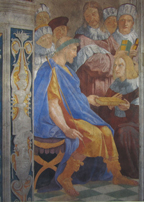 |
on the right of the window, with a larger space available, Raffaello drew Gregory IX receiving the Decretals (canon law), from St. Raymond de Penafort. |
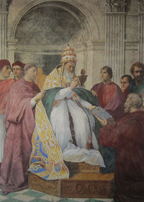 |
The Pope has the face of Julius II, the Cardinal on the left is Giovanni de’ Medici, the future Pope Leo X, behind whom are Alessandro Farnese, and Antonio del Monte. The design is by Raphael, while the painting is attributed to Baldassarre Peruzzi.
The Room of the Segnatura for the coexistence of many different subjects: narrative, allegory, number and recognition of characters, can disorient the unprepared visitor who might miss the meaning of the compositions, but also looking only at the aesthetics Raphael stuns for the incredible pictorial technique and the incomparable use of color.
back |

